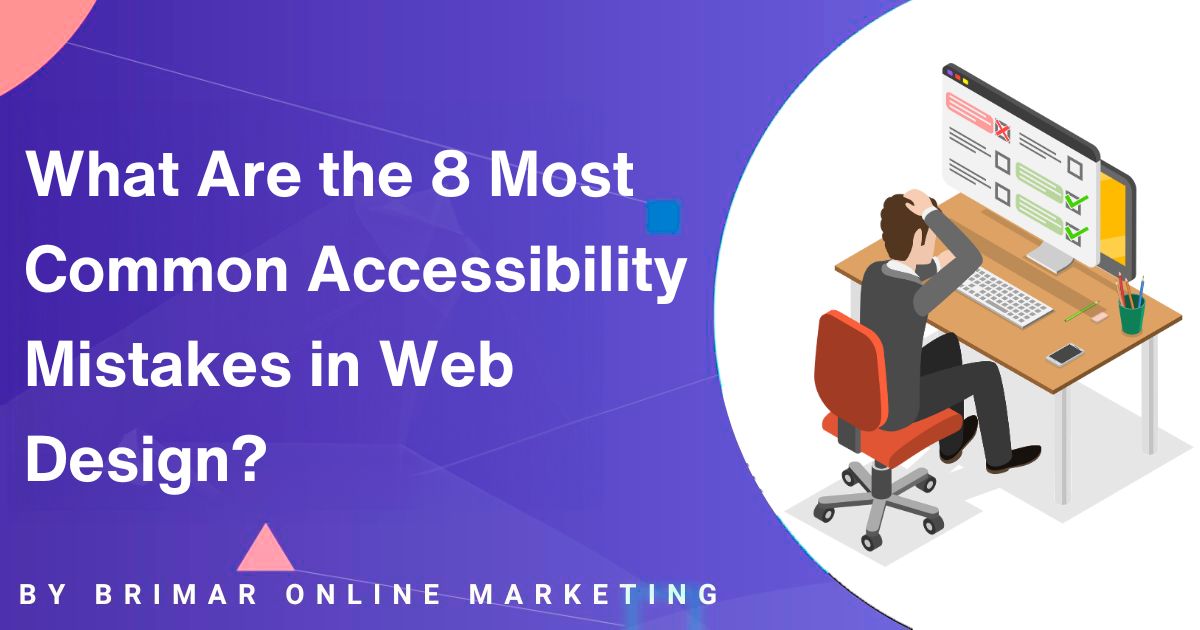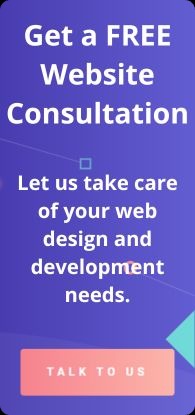
Accessibility isn’t optional anymore.
When a website isn’t accessible, it leaves people out, opens the door to legal risks, and damages trust.
Equal access online is now a legal requirement in many parts of the world, and it’s also simply the right thing to do.
The World Wide Web Consortium (W3C) developed the Web Content Accessibility Guidelines (WCAG Guidelines), which now serve as the foundation for accessibility standards worldwide.
These guidelines give web designers, developers, and content creators a clear path to follow so that everyone, regardless of ability, can use and enjoy digital spaces.
Here’s the good news: the most common accessibility mistakes are not difficult to fix.
With a little attention during the development process and by following best practices, it’s possible to prevent accessibility barriers and create better user experiences for all.
Mistake #1. Missing or Poor Alternative Text
Alternative text is one of the simplest yet most important parts of accessible web design.
The alt attribute enables screen readers to convey a description of an image to users who cannot see it.
Without it, screen reader users are left in the dark about what the image shows.
The most common mistakes include missing alt text, decorative images that aren’t appropriately tagged, or alt attributes that are vague and unhelpful.
For example, “image123.jpg” or “picture” doesn’t help anyone.
On the other hand, descriptive alt text provides context and meaning.
Text alternatives are significant for visual content such as infographics, charts, and video content.
Assistive technologies rely on descriptive text to communicate important information that sighted users can quickly understand.
Getting alt text right is one of the easiest ways to remove accessibility barriers.
Get a FREE Website Consultation
Let us take care of your web design and development needs so you can focus on your business. We can handle new websites, landing pages, website redesign, and even maintenance.
Contact us today to get a free website consultation!
Mistake #2. Low Color Contrast and Background Colors
Low-contrast text is among the most frequent mistakes in web accessibility.
When the contrast between text and its background colors is too low, people with low vision or color blindness struggle to read it.
According to WCAG guidelines, normal text should meet a minimum contrast ratio of 4.5:1, while large text, 18pt and up, or 14pt bold and up, should meet at least 3:1.
This ensures readability across different levels of vision.
Color contrast checker tools make it easy to test whether your design meets these standards.
It’s worth checking both standard text and large text because what looks fine in a heading may not work in body copy.
Fixing low color contrast doesn’t just help those with visual impairments.
It improves readability for everyone, whether they’re reading on mobile devices outdoors, dealing with glare on their screen, or simply skimming.
Adjusting contrast is a small step that delivers a huge boost in accessibility.
Mistake #3. Poor Page Structure and Use of Headings
A website without proper structure is like a book without chapters.
People who rely on assistive technology need clear headings and a logical hierarchy to understand the flow of content.
When headings are skipped or used out of order, screen readers can’t provide a smooth experience, and users may get lost.
Web designers often make the mistake of styling text to look like a heading without using semantic HTML.
That creates barriers for screen reader users and keyboard navigation.
The solution is simple: use proper heading tags (H1, H2, H3) in a way that reflects the page’s structure.
ARIA attributes and ARIA labels can help make complex layouts or interactive elements accessible, but they should be applied carefully.
Too many unnecessary ARIA roles can create confusion.
A strong foundation in semantic HTML, supported by ARIA only where needed, leads to accessible rich internet applications that feel seamless for real users.
When page structure is clean and logical, everyone benefits.
It makes content easier to scan, improves SEO, and reduces frustration for all types of users.
Mistake #4. Unclear or Empty Links
Links are supposed to guide people, not confuse them.
Yet many web pages are filled with empty links or vague link text like “click here” or “read more.”
For someone using a screen reader, this is meaningless.
They need descriptive text that tells them where the link will go or what action it performs.
Empty links are another common error.
They take up space in the code but lead nowhere, which is frustrating for keyboard users and screen reader users alike.
Good link text should be short, descriptive, and specific.
Instead of “click here,” try “download the accessibility checklist” or “learn about mobile applications.”
This kind of descriptive text provides equal access and clarity for everyone.
Fixing link text doesn’t just help people with assistive technologies; it improves navigation for all visitors.
Clear, descriptive links reduce confusion, build trust, and encourage more clicks.
Mistake #5. Inaccessible Forms and Input Fields
Forms are essential on most websites, whether they’re used for sign-ups, checkouts, or contact pages.
Unfortunately, they’re also one of the most common web accessibility mistakes.
The biggest issues usually involve form fields without labels, unclear instructions, or input fields that can’t be accessed with a keyboard.
Screen reader users rely on descriptive labels and ARIA labels to understand what each field is asking for.
Without them, completing a form becomes guesswork.
Error messages are another problem.
If a form field isn’t filled correctly but the error isn’t announced by assistive technology, users with visual impairments or cognitive disabilities may never know what went wrong.
Drop-down menus, checkboxes, and interactive elements must also be accessible with keyboard navigation.
People with mobility impairments may not use a mouse, so they depend on keyboard accessibility to move through form controls.
Getting forms right means making sure every input field has a descriptive text label, error messages are clear, and interactive elements respond to both mouse and keyboard users.
Accessible forms create smoother experiences for everyone, not just those using assistive technology.
Mistake #6. Ignoring Multimedia Accessibility
Multimedia can make content engaging, but if it isn’t accessible, it creates major barriers.
Video content without captions or audio descriptions excludes people with hearing or visual impairments.
A promotional video on a home page might look great, but without text alternatives, it’s just a blank space for screen reader users.
Visual cues in video and audio content must be paired with additional information in text or captions.
For example, if a video relies on text displayed on the screen, people with low vision or cognitive impairments may miss key details unless they’re provided in another format.
Accessibility standards require that multimedia include captions, transcripts, and, where possible, audio descriptions.
These aren’t just nice extras; they’re critical for equal access.
The good news is that adding captions and text alternatives also benefits a wider audience.
Many people watch videos on mobile devices with the sound off, and captions make content easier to follow in noisy environments.
When multimedia is accessible, it doesn’t just help a small group of users; it improves the experience for everyone.
Mistake #7. Overlooking Keyboard Navigation
Not everyone uses a mouse.
For many people with mobility impairments, cognitive disabilities, or visual impairments, the keyboard is the only way to navigate a site.
That’s why keyboard accessibility is one of the most critical accessibility standards.
When interactive elements such as drop-down menus, buttons, or links can’t be reached or activated using only a keyboard, it creates a wall between users and the content they need.
Common errors include focus traps, where the cursor gets stuck on one element, or skipped elements that can’t be reached at all.
The fix is straightforward: ensure all interactive elements can be accessed with the tab key, that the focus order makes sense, and that visible focus indicators are present.
Manual testing with real users is one of the best ways to uncover these barriers, since automated tools often miss them.
Strong keyboard navigation isn’t just about compliance.
It gives people confidence that they can move through your website without frustration, which makes for better user experiences across the board.
Mistake #8. Relying Only on Automated Tools
Automated tools are helpful.
They can flag missing alt attributes, low-contrast text, and other common accessibility errors in seconds.
But here’s the catch: they only catch part of the picture.
Certain accessibility issues, such as the relevance of descriptive alt text, the clarity of link text out of context, or the proper announcement of form error messages, depend on human judgment.
That’s why relying only on automation is one of the most common web accessibility mistakes.
Manual testing with assistive technologies, mobile devices, and real users with disabilities uncovers issues no scanner can.
It also helps content creators, web developers, and designers understand how people truly interact with their work.
The best practice is to combine both: use automated tools for quick checks during the development process, then validate with manual testing.
This approach reduces common mistakes and ensures your digital content is truly inclusive.
Final Thoughts
The most common web accessibility issues, missing alt text, low color contrast, poor page structure, empty links, inaccessible forms, and overlooked video content, are all avoidable.
Add to that the importance of keyboard navigation and the need to go beyond automated tools, and you’ve got a clear picture of the most common accessibility barriers.
The good news is that accessible design isn’t complicated.
When web designers, web developers, and content creators follow best practices and test their work against WCAG guidelines, they create digital spaces that offer equal access for everyone.
Website accessibility issues are no longer something that can be ignored.
Inaccessible websites risk legal action, reputational harm, and the loss of potential customers.
On the other hand, accessible web design leads to better user experiences, stronger trust, and wider reach across desktop, mobile devices, and mobile applications alike.
Inclusive websites aren’t just about compliance.
They’re about respect, empathy, and building digital content that serves real users.
When you make accessibility a priority from the start, you’re not just fixing common accessibility errors; you’re creating an online experience where everyone is welcome.
We Have Delivered High Quality Websites and Our Customers Are HAPPY!
“Good quality and responsive service. Isaias is a professional person, he is always aware of the needs of his clients. He has always helped me in my projects.”
CEO

